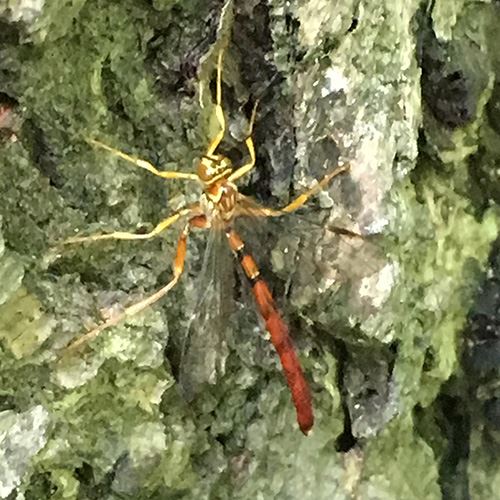Buried Treasure

By Karen Menard
The dying tree in all of its decay still held a treasure. Hidden deep inside its wooden vault, a “beauty” slept patiently…waiting. The sleeping beauty in this case is a female wasp called the giant “Ichneumon,” or Megarhyssa--one of the most flamboyant wasps in North America; yet, for its large size and intimidating ovipositor, is gentle, shy, and incapable of stinging humans.
Only the male ichneumons know the secret that the life-giving tree would soon reveal--they could hear her waking! One male wasp, and then another, flew in and hovered both anxiously and nervously. Drawn in and focused, each moved from side to side, carefully listening for sounds of delicate chewing coming from her cambium crypt. Finally, she emerges onto the trunk to be met by one of the male wasps patiently waiting. The quote, “All things come to he who waits—provided he knows what he is waiting for (W. Wilson),” rings true in this situation.
Biologically, the male wasps inherently know that waiting for the females will ensure the next generation’s success. Timing is everything as these male ichneumons will only mate with newly emerged females, so each must act swiftly. The female, whose adult lifespan measures just under one month, quickly kick starts the next generation by laying eggs in the next appropriate rotting tree or stump.
Considered a parasitoid species in the Megarhyssa wasp genus, these animals cannot just lay their eggs in any old stump or tree. They must locate a jackpot of a wood-boring wasp, called the Pigeon horntail (Tremex columba) and parasitize them. It is speculated that she accomplishes the discovery of grubs by engaging her excellent senses of hearing or smell. But, how does she accurately position herself upon a hidden horntail larva buried deep inside the wood? The exhausting, forty or so minute process begins and ends with patience only after an arduous search.
Taking her time, she stands tall while unfurling her 3-5 inch long, streaming, whip-like ovipositor. This special appendage is made up of three filaments—one central tube and two others that form a sheath enabling stability and overall protection. After several attempts to position her ovipositor into the correct place, it appears that she drills into the wood and artfully weaves her ovipositor between the cracks and crevices. Once the egg deposit is complete, the small wasp larva will eventually attach itself to the doomed grub—only after the horntail develops and gets a little juicier.
Ichneumon wasp larvae will spend the fall, winter and spring seasons inside the tree, eating and sleeping. The next generation of these amazing insects will be awakened again in the Metroparks via the warmth of next summer’s arrival.
Did you know?
This type of long ovipositor recently inspired a zoologist and mechanical engineer to create a steerable needle for use in brain surgery and difficult medical procedures.
---
Photo: Megarhyssa greenei; Karen Menard, Providence Metropark